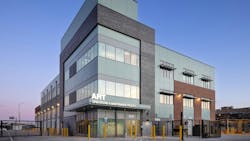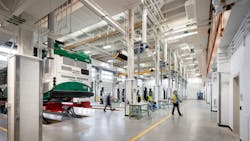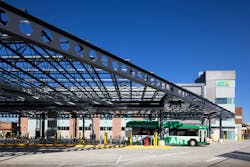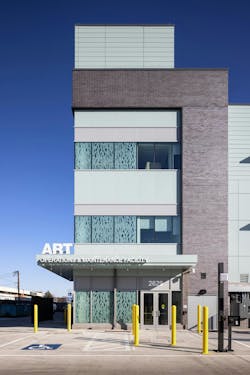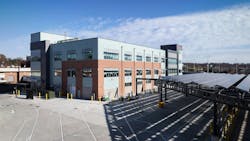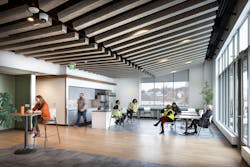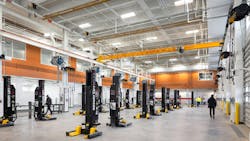Arlington Transit’s New Facility Accelerates Battery Electric Bus Fleet, Zero-Emissions Goal
The Arlington Transit (ART) operation and maintenance facility opened in November 2024 in Arlington County, Virginia, bringing a more sustainable transit future to the region. Designed by Stantec and built by Turner Construction Company, the new facility serves as ART’s centralized, modern headquarters and meets the needs of the company’s growing operations with a battery electric bus (BEB) fleet. This new facility supports Arlington County’s goal of carbon neutrality by 2050 and ART’s commitment to a resilient future with zero-emission buses.
Adaptive Design for Growth and Resilience
While meeting the community’s needs today, ART’s new headquarters is built to adapt for future growth while supporting significant charging infrastructure, the city’s sustainable goals, and employee well-being. Greg Shipley, principal for Stantec’s Arlington Civic and Transit studio, said the project scope included constructing two new structures on a site bisected by a private access road and a regional stream known to flood.
“The two new structures, a three-story 49,485-square-foot Operations and Maintenance Building and a 65,096-square-foot four-tier parking structure, are positioned within the reprogrammed site to support transit operations,” he said. “The Operations and Maintenance Building provides ART a centralized facility to perform maintenance on their bus fleet, improving efficiency while minimizing deadhead miles.”
The three-story Operations and Maintenance Building was delineated by function, with the first-floor layout supporting employees focused on fleet maintenance. The design includes repair bays, workshops, parts rooms, and utility spaces. The second floor was designed for maintenance administration with a maintenance suite; conference, break, training, and parts rooms; and employee lockers and restrooms. The third floor has an administrative suite with offices, break and conference rooms, and future fit-out space, as well as an operations area and shared spaces from wellness and quiet rooms to an exterior patio with a vegetative roof.
ART committed to a BEB in the midst of construction, which sparked the collaboration between Turner Construction and Stantec.
“When Arlington County committed to a future battery electric bus fleet midway through construction, we knew Stantec was the ideal partner to help us meet the county’s exciting goals for community transit,” said Patrick Gallagher, senior project manager with Turner Construction. “Bringing together integrated design and construction teams with Arlington’s forward-thinking approach, we elevated the sustainability focus and now anticipate LEED Platinum certification for the facility.”
Stantec used ZEVDecide and knowledge of zero-emission technology to conduct predictive power modeling about the fleet charging requirements to find the optimal charging solution. This furthered efforts to support ART’s 2050 carbon neutrality goal. Shipley noted how the original CNG bus parking stalls were preserved and allowed buses to be stacked four-deep.
“BEBs require significant charging infrastructure to provide power to the buses,” Shipley said. “The charging infrastructure of the transformers, switchboards, generators, and fast chargers are aligned south of the building in an efficient, linear layout, similar to the stacked buses.”
Smart Infrastructure and Site Planning
A challenge with the design was building a system to support a future transition to a BEB fleet. A multi-phased approach was set for the facility, focusing on a comprehensive charging infrastructure, expansion, and a future-proof facility design. The site has 10-inch, heavy-duty concrete paving to support the county’s procurement of heavier BEBs with longer range in the future.
Phase one focuses on the charging infrastructure—one mast supercharger, 12 pantograph chargers, six overhead CCS1 plug-in chargers, and full underground systems, with a transformer and switchgear sized for the full BEB buildout. Two natural gas generators are within phase one since the required charging power demand exceeded the onsite power available. Stantec worked with the local electric utility to bring power to ART from the Four Mile Run transmission line, located less than a mile away.
“The charging stations are aligned with the centralized vertical support structure,” he said. “The structure will support the overhead pantographs as well as photovoltaic (PV) panels above. The structure will cantilever to provide additional cover and PV placement over the bus stalls.”
Phase two adds 24 pantograph chargers, including at the plug-in charger sites, and a third natural gas generator. Eight pantograph chargers and a second mast supercharger will be installed during phase three.
“The total BEB build out will be two mast superchargers, 38 pantograph chargers, and six pantographs plus plug-in chargers, for a total of 46 BEB bus spaces with charging, and there will be eight additional bus spaces without charging,” Shipley said.
The selected pantographs offer a range of height adjustability to accommodate varied bus designs. Electrical distribution equipment can handle additional charging capacity and charge management will assist with power distribution as vehicle requirements change.
The third-floor administration area has future fit-out spaces for staffing growth. The cast-in-place concrete parking garage with brick tiles throughout supports a cohesive campus design. Within the stairwell are biophilic patterned screen panels, a playful design element visible from Shirlington Road. The garage can also expand to a fifth floor for additional parking or business needs.
Another challenge was maximizing the square footage while accommodating ART’s needs for BEB fleet equipment. Arlington County is a semi-urban area with limited open space, and the site’s unusual shape limited total coverage for BEBs.
“The infrastructure required for battery electric charging takes up a lot of space, so early studies showing each charging equipment component (transformer, switchgear, chargers, and generators) were developed to show how that would affect bus parking and movement,” he said. “The structure to support the pantograph chargers also had to be designed for bus movement and to avoid the underground stormwater management system.”
When integrating charging infrastructure, Shipley said the development of safe and efficient site circulation was critical. That infrastructure had to be accommodated and protected from vehicle traffic while avoiding the underground stormwater management system.
“Autoturn movements were performed for buses, fire engines, and delivery vehicles to ensure site circulation,” he said. “Coordination between structural and civil engineering and shop drawings occurred to avoid construction issues.”
Shipley shared the role of renewable energy, noting the project boasts 817 solar panels that deliver up to 397 kW (AC) to support the facility’s operations and future growth. The solar array provides on-site energy for the building.
“Arlington County’s transition to BEBs will eliminate bus emissions while they transport people through the community,” Shipley said. “By implementing zero-emission buses and transit system electrification, we can combat climate change, improve air quality, and provide a stable infrastructure that is less reliant on fossil fuels and fluctuating energy costs.”
Arlington Transit’s new facility reduces carbon emissions within the community from the transition to a BEB bus fleet and incorporates renewable energy systems across the site for a resilient step toward carbon neutrality for years to come.
ART Bus Operations and Maintenance Facility At a Glance
- 3 stories
- 49K SF O&M Facility
- 65K SF Four-Tier Parking Structure
About the Author
Lauren Brant
Buildings Editor
Lauren Brant is the editor of Buildings. She is an award-winning editor and reporter whose work appeared in daily and weekly newspapers. She strives to create content that is informative and actionable for professionals, helping them discover new products, technology, and insights to make smarter building decisions. In 2020, the weekly newspaper won the Rhoades Family Weekly Print Sweepstakes—the division winner across the state's weekly newspapers. Lauren was also awarded the top feature photo across Class A papers. She holds a B.A. in journalism and media communications from Colorado State University-Fort Collins and a M.S. in organizational management from Chadron State College.
